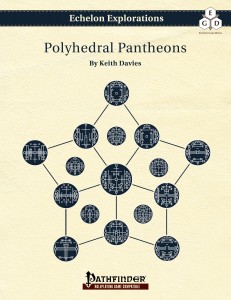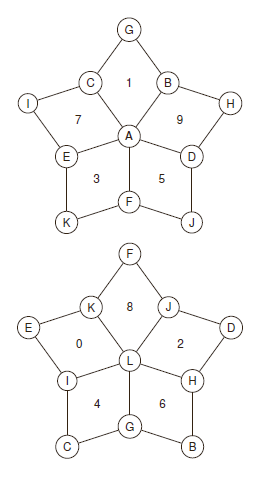
The halfling pantheon is rather kinder than the Goblin Pantheon, but not as well-rounded as the Elemental Tetratheon. There is a strong focus on community, and the Death, Evil, Fire, and Magic domains are all absent.
Creating the Halfling Pantheon
The polyhedral pantheon process can be summarized quite simply.
- Choose a polyhedron.
- Assign a domain to each point and face.
- Group domains for each god.
- Determine the ‘chosen weapon’ of each god.
This provides all the information needed to use the gods in play. There is no setting-specific information here, but it is enough for a cleric to choose her god and domains.
Let’s begin.
Step 1: Choose a Polyhedron
I want a moderately well-rounded pantheon, using most of the primary domains (those from the Revised System Reference Document), with replacements for the Death, Evil, Fire, and Magic domains. As with the Goblin Pantheon, I will use a d10.
This gives me twenty-two sites (twelve points and ten faces) to assign domains to and to represent deities.
Step 2: Assign Domains to each Point and Face

The diagram to the right presents the points (circled letters) and faces (numbered areas) of the polyhedron I am using.
I am deliberately placing the domains, choosing which domain will be assigned to each site. I have pretty specific ideas for some of the gods and this method gives me the most control.
The halfling culture is going to start off almost as the stereotypical, stay-at-home type of halfling. After assigning the domains this may change somewhat, but for now I am looking for a culture based around homebodies, comfortable in their simple lives.
The domains assigned to each face are:
- Liberation
- Animal
- Law
- Travel
- Protection
- Luck
- Healing
- Sun
- Plant
- Air
The domains assigned to each point are:
- Community
- Trickery
- Repose
- Water
- Nobility
- Rune
- Chaos
- Earth
- Good
- War
- Knowledge
- Weather
I could see while assigning domains that I will be adjusting my expectations regarding the halfling culture.
Step 3: Group Domains for Each God
Each god’s primary domain is in bold text, and alignments are (in parentheses). As before, alignment is initially determined by alignment domain assignments.
- (CN) Liberation, Community, Trickery, Repose, Chaos
- (TN) Animal, Water, Earth, War, Weather
- (LN) Law, Community, Nobility, Rune, Knowledge
- (CG) Travel, Repose, Chaos, Good, Weather
- (TN) Protection, Community, Water, Rune, War
- (CN) Luck, Trickery, Chaos, Earth, Weather
- (NG) Healing, Community, Repose, Nobility, Good
- (TN) Sun, Rune, War, Knowledge, Weather
- (TN) Plant, Community, Trickery, Water, Earth
- (NG) Air, Nobility, Good, Knowledge, Weather
The Travel domain is associated with Chaos (which is viewed with suspicion) but also Good. Maybe a bit of wanderlust is not completely discouraged? Travel is also associated with the Repose domain, and no deity in this pantheon has the Death domain. I think perhaps a small group of itinerant layers-to-rest, traveling from village to village to see that the dead are properly seen to.
It seems that Travel, despite the association with Good, is seen as a bit uncanny or uncomfortable to others.
Let’s see where the point gods take us.
- (LN) Community, Liberation, Law, Protection, Healing, Plant
- (TN) Trickery, Liberation, Luck, Plant
- (TN) Repose, Liberation, Travel, Healing
- (TN) Water, Animal, Protection, Plant
- (LN) Nobility, Law, Healing, Air
- (LN) Rune, Law, Protection, Sun
- (CN) Chaos, Liberation, Travel, Luck
- (TN) Earth, Animal, Luck, Plant
- (NG) Good, Travel, Healing, Air
- (TN) War, Animal, Protection, Sun
- (LN) Knowledge, Law, Sun, Air
- (TN) Weather, Animal, Travel, Luck, Sun, Air
Much nice than the goblin pantheon. Some good, but a lot of neutrality here (5 LN, 3 NG, 3 CN, 10 TN; 1 CG).
The domain combinations, though, intrigue me. Liberation domain is probably more often associated with Chaos than Law, and the ‘god of Liberation’ has the Chaos domain… but the focus of the pantheon, Community, has both the Liberation and Law domains. Repose and Liberation, I now have an image of ‘halfling exorcists’ breaking the bonds of restless spirits and letting them move on. I didn’t expect that, but the ‘Repose god’ having both the Liberation and Luck domains (which are both linked to Chaos) moves this into the uncanny group.
I’m starting to get a feeling of a dichotomous society. Most are relatively staid homebodies, probably with a leavening of members who provide necessary services and are seen as uncanny. The majority of halflings still treat them as… not _coldly_ polite, but perhaps formally and uncomfortably polite.
Step 4: Determine the ‘Chosen Weapon’ of Each God
Again, I will delay choosing the favored weapons of the gods until I have had a chance to think about it. I don’t need this information quite yet, and the pantheon is going in a bit different direction than I anticipated.
Closing Comments
A bit of a surprise here. I didn’t plan for it to happen quite this way, I was expecting to end up with a more or less stereotypical ‘halfling pantheon’. The pantheon is generally positive, but still has a great deal of neutrality to it. Halflings are not noted crusaders, as a rule, so that’s appropriate. However, while halflings might be generally seen as being orderly, I have the sense that many of the standout characters, including many of their heroes and major figures, are likely to have at least a (perceived) taint of chaos or the uncanny.
This surprised me a bit, but now I’m rather more intrigued in this culture as a whole. I think it’ll go somewhere rather less stereotypical than I’d aimed for — it retains much of the expected structure, but has enough quirks and outliers that I want to develop this further.
Pingback: Quick Update on Polyhedral Pantheons | Keith Davies — In My Campaign - Keith's thoughts on RPG design and play.
Pingback: Kouzelnik Deities of the Goblin Pantheon | Keith Davies — In My Campaign - Keith's thoughts on RPG design and play.